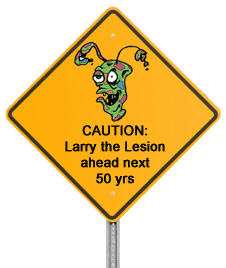"A warning about hepatotoxicity has been added to the prescribing information. Signs of liver injury, including markedly elevated serum hepatic enzymes and elevated total bilirubin occurred as early as six days after the first dose, according to the letter, which is signed by Dr. Michael Panzara, Biogen's chief medical officer of neurology, and Dr. Gordon Francis, Elan's senior vice president of global clinical development.
'Signs of liver injury have also been reported for the first time after multiple doses,' the letter added. 'In some patients, liver injury recurred upon rechallenge, providing evidence that Tysabri caused the injury.'
Any patients exhibiting signs of jaundice or other evidence of liver injury should discontinue Tysabri."
100,000 hits!
Dermatologist Appointment
MRI says more than you think
"The researchers report clinical and MRI findings after a five-year follow-up in 30 patients with subclinical demyelinating lesions fulfilling Barkhof criteria seen on MRI performed for medical complaints such as headache or trauma.
All patients had a normal examination and biological screening, the authors report, but all patients had increased CSF immunoglobulin levels (including nine with oligoclonal bands) and eight patients had abnormal asymptomatic visual evoked potentials.
Eleven patients clinically converted, including five with optic neuritis, three with diplopia or internuclear ophthalmoplegia, two with paresthesias in the lower limbs, and one with cognitive deterioration.
Four of these patients had their first clinical events during the first year after the first abnormal MRI, three during the second year, three during the third year, and one at five years. The mean time between the abnormal MRI and the clinically isolated syndrome was 2.3 years.
All 17 patients who underwent a second MRI during the first year showed MRI dissemination, the researchers note, as did eight of 12 patients whose second MRI was done between 12 and 24 months.
"For the pre-MS patient, without clinical events but with evidence of dissemination to time and space, medical discussion on the therapeutic options of immunomodulatory agents for reducing the risk of MS should be conducted, with the knowledge that subclinical MS can evolve into relapsing remitting MS in the majority of cases or more rarely into progressive MS," the investigators advise.
"Physicians and especially neurologists must really know Barkhof and McDonald criteria to not overestimate the diagnosis of MS," Dr. Lebrun-Frenay said. "A lot of abnormal MRI with T hyperintensities are classified MS, but a lot of physicians forget what Barkhof and Tintoré said in their principal publications on the way to interpret brain MRI."
9 month check-in for Fingolimod trial!
So, this starts the final countdown on Avonex injections left to do for the trial! THIRTEEN LEFT TO GO!!! I'm still so shocked at how well I handle my injections since starting them 9 months ago. I think about that first time I had to do it on my own and how I hovered for 15 minutes or more on several occasions in fear of stabbing myself. I was even feeling more confident while giving blood yesterday that I almost looked down at my arm to watch her take the blood! I thought that might tempt fate, so I just looked right at my nurse which I typically don't do either. Usually I stare in the opposite direction so there wouldn't be a chance I could see anything needle or blood related. But I really do feel comfortable with it all now. I don't get even a slight fainting feeling any more. I didn't even have to self talk myself to remember to breath like I first started doing in the trial. I don't have any negative reactions any more! Perhaps on my next appointment I'll have a glance down and see how I feel :) Feeling proud about where I came from though!
Tysabri and skin cancer connection? Ouch!
"According to a report in the Feb. 7 issue of The New England Journal of Medicine, doctors have observed that two multiple sclerosis patients developed malignant melanoma, a deadly form of skin cancer, soon after starting treatment with Tysabri (Natalizumab).
A 46-year-old woman with multiple sclerosis had a mole on a shoulder for a long time. As soon as she was administered the first dose of Tysabri, there was a rapid change in the mole. It developed into malignant melanoma with metastatic spread to her regional lymph nodes.
Another 45-year-old woman had a mole on the back of her eye and had it monitored by doctors since 1999. It was found to be stable all along until she was given several infusions of Tysabri recently. The mole grew in size, shape and pigment and was identified as ocular melanoma. This woman however has a family history of melanoma.
Timothy K. Vartanian, MD, PhD, chief of the multiple sclerosis division at Beth Israel Deaconess Hospital and associate professor of neurology at Harvard Medical School is of the opinion that Tysabri could have triggered melanoma in the two patients with multiple sclerosis. Vartanian and colleagues report the two cases in a letter to the Feb. 7 issue of The New England Journal of Medicine."


